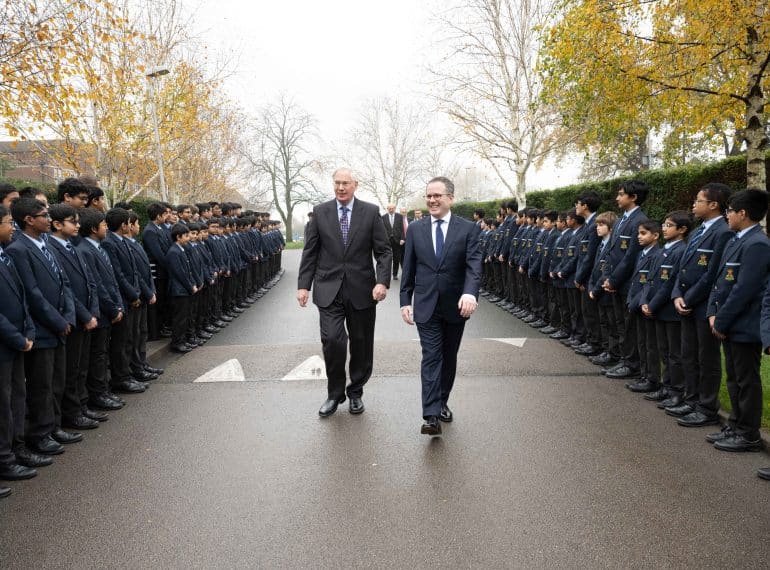
HRH The Duke of Gloucester today visited QE, as the reigning Sunday Times State Secondary School of the Year prepares to celebrate its 450th anniversary early next year.
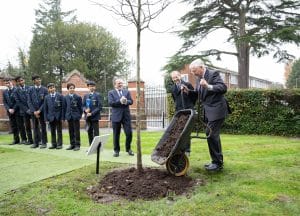 Members of the School’s Combined Cadet Force flanked the main entrance and the senior rugby team provided a sporting backdrop as the Duke arrived for his visit, during which he marked the anniversary by planting an oak tree and by presenting a specially embroidered banner to Headmaster Neil Enright.
Members of the School’s Combined Cadet Force flanked the main entrance and the senior rugby team provided a sporting backdrop as the Duke arrived for his visit, during which he marked the anniversary by planting an oak tree and by presenting a specially embroidered banner to Headmaster Neil Enright.
The visit had an eye to the future as well as the past: the Duke was given a demonstration of VEX Robotics – QE is a multi-time UK champion and was the first UK school to win a World Championship title – and even tried out driving the robots himself.
He came to QE almost exactly 90 years after another royal visit, by HRH The Prince George, Duke of Kent, who opened the new buildings – still in use as QE’s Main Building – following the School’s relocation from its historic Tudor Hall site in Wood Street, Barnet.
 Following the visit, Mr Enright said: “It was a tremendous honour and my great pleasure to welcome HRH The Duke of Gloucester today. With the anniversary fast approaching, there was much to show him, including the School’s original 1573 Charter signed by Elizabeth I, our Ties through Time installation of 232 School photographs from the 1880s until comparatively modern times, and, to bring things right up to date, the robots and our new Music building, opened in May.
Following the visit, Mr Enright said: “It was a tremendous honour and my great pleasure to welcome HRH The Duke of Gloucester today. With the anniversary fast approaching, there was much to show him, including the School’s original 1573 Charter signed by Elizabeth I, our Ties through Time installation of 232 School photographs from the 1880s until comparatively modern times, and, to bring things right up to date, the robots and our new Music building, opened in May.
“The Duke showed a keen interest in everything, and I know our roboteers will be especially delighted that he was brave enough to try his hand at the controls of two of their creations.”
On his arrival, the Duke was presented to the Headmaster by Martin Russell, Representative Deputy Lieutenant of the London Borough of Barnet and a former QE parent.
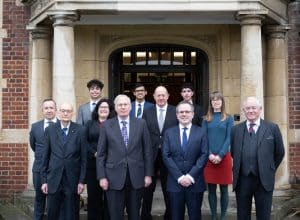 He was then introduced to:
He was then introduced to:
- Barrie Martin, MBE (Chairman of Governors and Chairman of the Friends of Queen Elizabeth’s)
- Nick Gaskell (Vice-Chairman of Governors)
- The three Deputy Heads: Anne Macdonald (Academic); David Ryan (Pastoral) and Tara O’Reilly (Operations)
- School Captain (head boy) Theo Mama-Kahn, and Senior Vice-Captains Ansh Jassra and Antony Yassa, all of Year 13.
The Duke was shown the charter and Royal Seal, together with original artefacts from the 1932 royal visit drawn from the School’s archives. The materials were introduced by Jenni Blackford, Curator of QE Collections and Head of Library Services, and two Year 13 boys involved in the work with the archives, Ishaan Mehta and 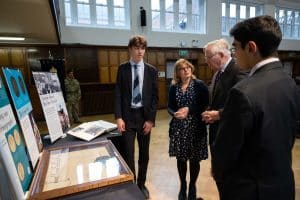 Gabriel Gulliford.
Gabriel Gulliford.
The Headmaster then gave a formal welcome to the Duke in front of 100 selected pupils in the Main School Hall. He said: “Your Royal Highness, it is my honour and privilege to offer you the warmest welcome on behalf of the Elizabethan community…2022 has been a year full of accomplishment at the School. We have had our status as an outstanding school confirmed by Ofsted, been named State Secondary School of the Year by The Sunday Times, and opened The Friends’ Recital Hall and Music Rooms – the latest enhancement to our campus, built from the generosity of our School community. You could say it has been our annus mirabilis.”
QE’s Senior Barbershop group sang the hymn Abide with Me while the new School banner was brought into the hall by a representative of the CCF. Commissioned in advance of the 450th anniversary service being held in Westminster Abbey on 24th March 2023, the banner was passed to the Duke, who presented it to the Headmaster.
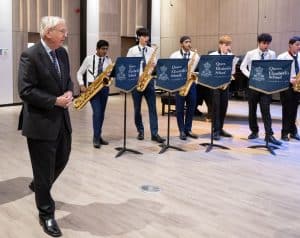 After visiting the Ties through Time photographic installation and enjoying the robotics in the School’s Conference Centre, the royal party headed to the new Music building to watch rehearsals for this Thursday’s Winter Concert under the watchful eye of Director of Music Ruth Partington.
After visiting the Ties through Time photographic installation and enjoying the robotics in the School’s Conference Centre, the royal party headed to the new Music building to watch rehearsals for this Thursday’s Winter Concert under the watchful eye of Director of Music Ruth Partington.
Then it was back to the front of the School before the Duke walked down the drive, lined by Year 7 pupils, stopping close to the gates to plant the anniversary oak tree. It is intended that the tree, which has been marked with a commemorative plaque, will come into full leaf for the first time at the School in the spring of 2023.
The tree will also form part of The Queen’s Green Canopy project inaugurated to mark Queen Elizabeth II’s Platinum Jubilee. Senior Vice-Captain Antony Yassa read a short extract from the wording of a new anthem composed for the anniversary year by internationally renowned composer, Howard Goodall, which is to receive its debut performance in Westminster Abbey in March: “Let us fill this place with hope. Face fate and fortune in our stride. That like an oak, we draw our strength from ancient roots spread deep and wide. From ancient roots spread deep and wide.”
Pupil representatives from the School’s Eco Network and its six Houses placed soil at the base of the tree, with the Duke invited to complete the process.

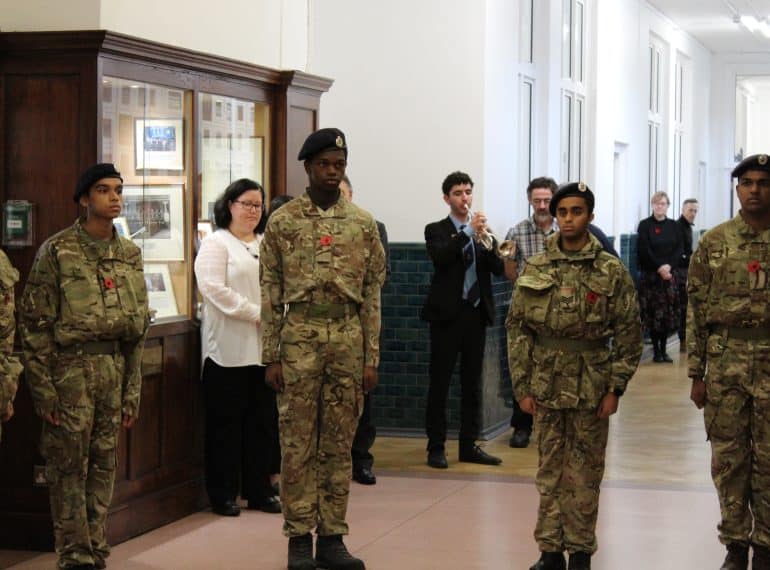
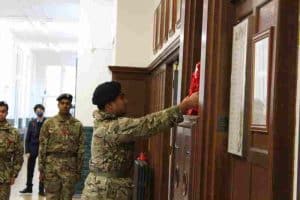 Through the two events, today’s Elizabethans remembered the 113 old boys who lost their lives in the 20th century’s two world wars and those who have been injured or died in wars since.
Through the two events, today’s Elizabethans remembered the 113 old boys who lost their lives in the 20th century’s two world wars and those who have been injured or died in wars since.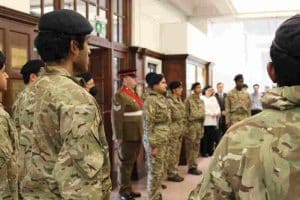 QE’s traditional 11.00am act of remembrance took place at the School’s World War I memorial in the Crush Hall. It was led by representatives of the School’s Combined Cadet Force, who were joined by Colour Sergeant Rhys Peto, the CCF’s School Staff Instructor, who is a member of QE’s Facilities Team.
QE’s traditional 11.00am act of remembrance took place at the School’s World War I memorial in the Crush Hall. It was led by representatives of the School’s Combined Cadet Force, who were joined by Colour Sergeant Rhys Peto, the CCF’s School Staff Instructor, who is a member of QE’s Facilities Team.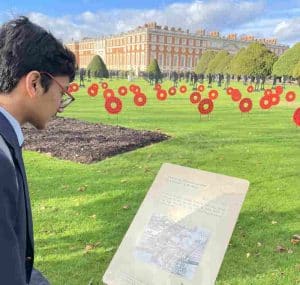 Two days later, 36 of the School’s cadets and CCF staff representatives participated in High Barnet’s Remembrance Sunday events. After assembling at Barnet Army Reserve centre in St Albans Road, they paraded down Barnet High Street and joined the church service at St John the Baptist Church, where there was the playing of the Last Post and a wreath-laying ceremony. Events concluded with a march-past, where Martin Russell, the Representative Deputy Lieutenant for the London Borough of Barnet (and the parent of an Old Elizabethan) took the salute.
Two days later, 36 of the School’s cadets and CCF staff representatives participated in High Barnet’s Remembrance Sunday events. After assembling at Barnet Army Reserve centre in St Albans Road, they paraded down Barnet High Street and joined the church service at St John the Baptist Church, where there was the playing of the Last Post and a wreath-laying ceremony. Events concluded with a march-past, where Martin Russell, the Representative Deputy Lieutenant for the London Borough of Barnet (and the parent of an Old Elizabethan) took the salute.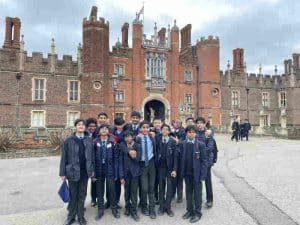 Helen Edmunds, Head of History & Politics, said: “Hampton Court provides excellent contemporary sources, including a display of diaries and letters written by the soldiers who were there just over a century ago. This links in well in with the work our pupils will do next year when they enter Year 9 on the role and importance of Empire troops during World War I and World War II.
Helen Edmunds, Head of History & Politics, said: “Hampton Court provides excellent contemporary sources, including a display of diaries and letters written by the soldiers who were there just over a century ago. This links in well in with the work our pupils will do next year when they enter Year 9 on the role and importance of Empire troops during World War I and World War II.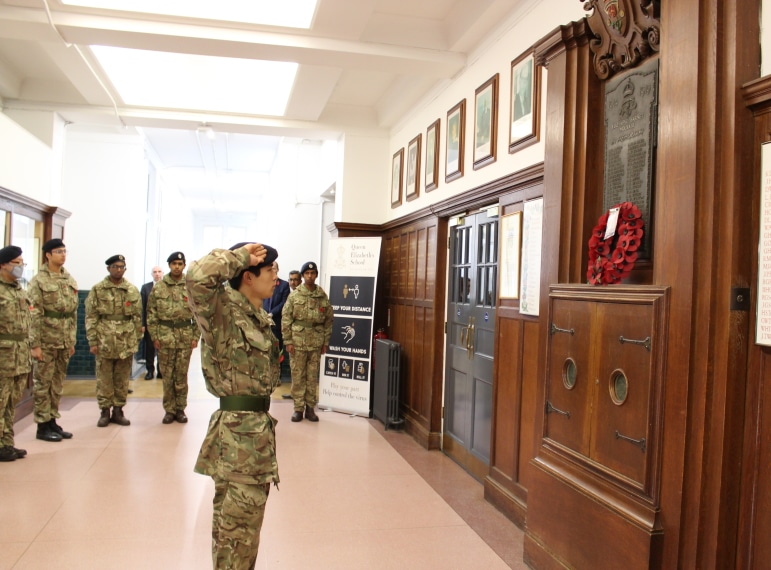
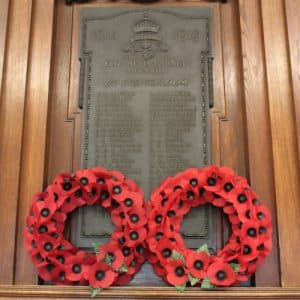 The cadets paraded into the Crush Hall, the area just outside the Main Hall, at 10.55am to take up their positions ahead of the 11am silence. They were led by Cadet Staff Sergeant Lucas Lu, of Year 13, who gave the commands and laid the wreath at the World War I memorial on behalf of the CCF and School.
The cadets paraded into the Crush Hall, the area just outside the Main Hall, at 10.55am to take up their positions ahead of the 11am silence. They were led by Cadet Staff Sergeant Lucas Lu, of Year 13, who gave the commands and laid the wreath at the World War I memorial on behalf of the CCF and School.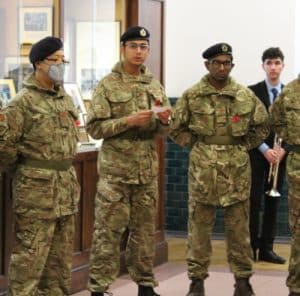 “In saluting th0se Elizabethans from generations past who gave their lives for a cause greater than themselves, we firstly pay tribute to their sacrifice and secondly encourage our current pupils to reflect on the School’s long and continuing tradition of service.”
“In saluting th0se Elizabethans from generations past who gave their lives for a cause greater than themselves, we firstly pay tribute to their sacrifice and secondly encourage our current pupils to reflect on the School’s long and continuing tradition of service.”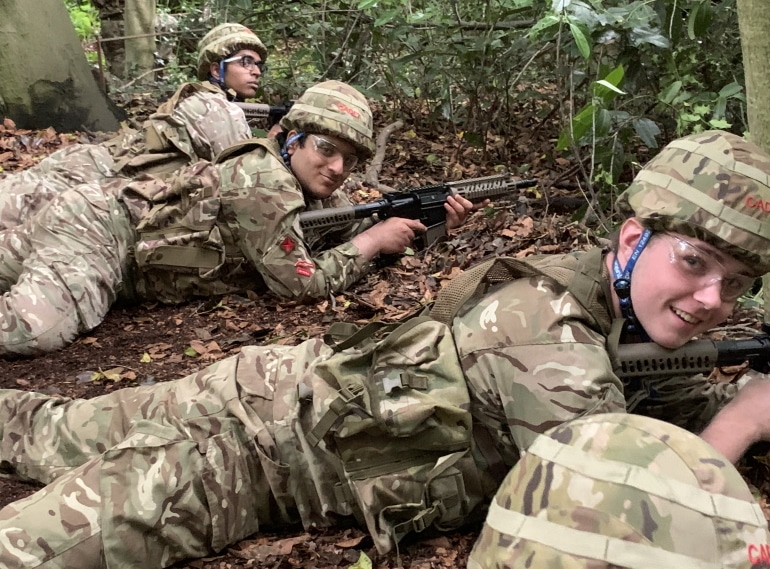
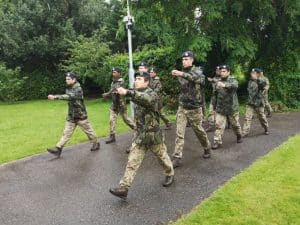 Cadets from Year 10 to Year 12 travelled to the camp in Hampshire and battled it out in an inter-section competition designed to test their abilities in activities ranging from archery to drill.
Cadets from Year 10 to Year 12 travelled to the camp in Hampshire and battled it out in an inter-section competition designed to test their abilities in activities ranging from archery to drill.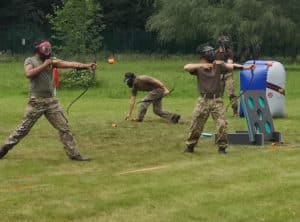 These included the strictly regimented Queens Guard Drill and the “rather more chaotic archery tag”, where the boys enjoyed the chance to fire rubber arrows at each other – “with varying success”, as Major Armon reports.
These included the strictly regimented Queens Guard Drill and the “rather more chaotic archery tag”, where the boys enjoyed the chance to fire rubber arrows at each other – “with varying success”, as Major Armon reports.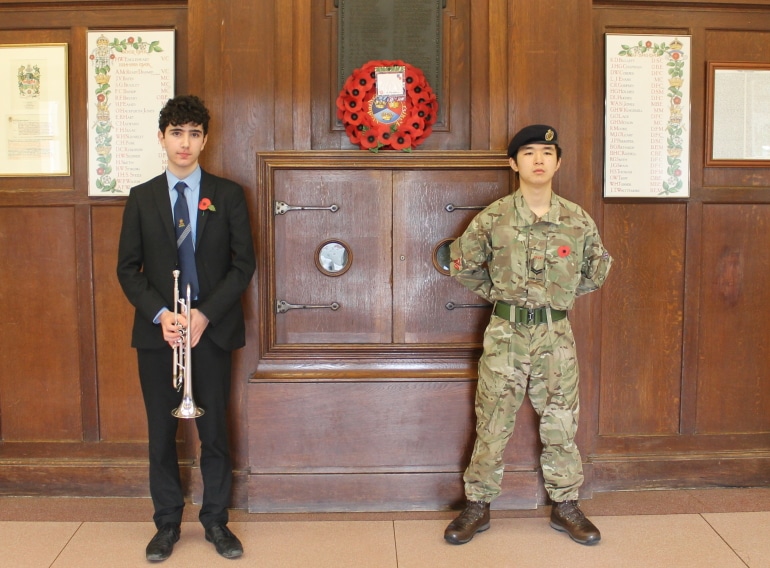
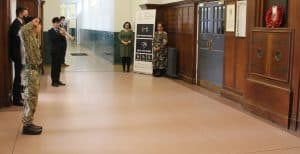 When boys fell silent at 11am on 11th November it was in their classrooms, while a smaller-than-usual wreath-laying ceremony took place at the World War I Memorial outside the Main School Hall.
When boys fell silent at 11am on 11th November it was in their classrooms, while a smaller-than-usual wreath-laying ceremony took place at the World War I Memorial outside the Main School Hall.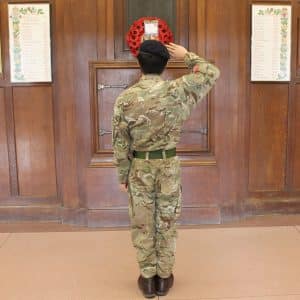 The bugler who played the Last Post and Reveille at the School ceremony was Theo Mama-Kahn, of Year 11, who is studying GCSE Music. The cadet laying a wreath was Lucas Lu, of Year 12.
The bugler who played the Last Post and Reveille at the School ceremony was Theo Mama-Kahn, of Year 11, who is studying GCSE Music. The cadet laying a wreath was Lucas Lu, of Year 12.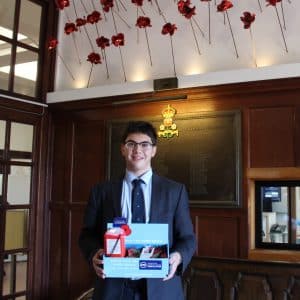 To ensure boys of all ages understood the significance of the occasion, a PowerPoint presentation detailing the history of the day was sent to form tutors to spark discussion among the pupils. It explained the importance of poppies – the first flowers to bloom on the World War I battlefields of Belgium and France – and included the famous poem they inspired, John McCrae’s In Flanders fields. Boys were also invited to watch a
To ensure boys of all ages understood the significance of the occasion, a PowerPoint presentation detailing the history of the day was sent to form tutors to spark discussion among the pupils. It explained the importance of poppies – the first flowers to bloom on the World War I battlefields of Belgium and France – and included the famous poem they inspired, John McCrae’s In Flanders fields. Boys were also invited to watch a 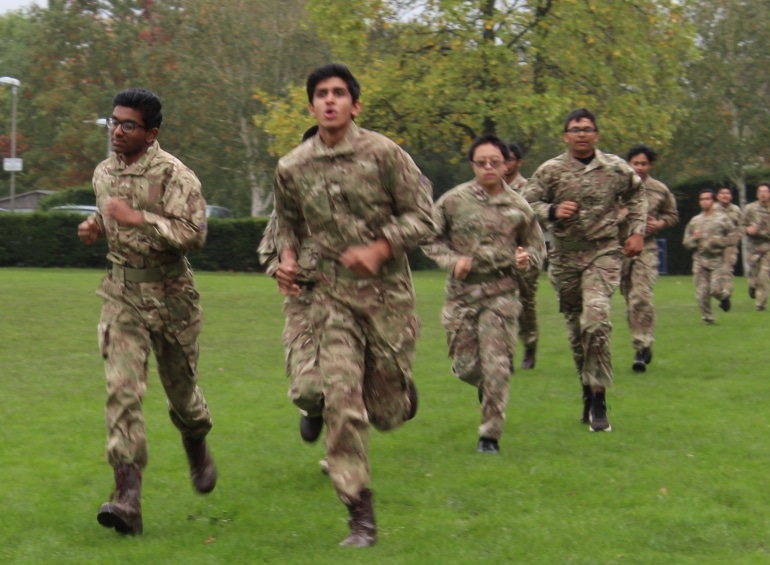
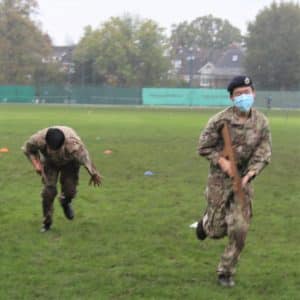 The cadets will be battling it out for the rest of the term in a series of activities focused on refreshing their basic skills in field craft, weapon-handling and drill.
The cadets will be battling it out for the rest of the term in a series of activities focused on refreshing their basic skills in field craft, weapon-handling and drill.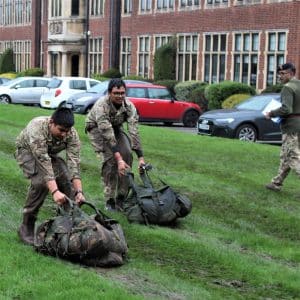 The first two weeks are focusing on Battle Field PT [physical training], including a ‘basic fitness test run’, ‘casualty drag’, ‘fire team fire-and-manoeuvre stand’ and a ‘jerry can carry stand’. This is being run by 2nd Lieutenant Richard Scally (Head of Cricket & Head of Aquatics), assisted by Physics teacher Jonathan Leigh.
The first two weeks are focusing on Battle Field PT [physical training], including a ‘basic fitness test run’, ‘casualty drag’, ‘fire team fire-and-manoeuvre stand’ and a ‘jerry can carry stand’. This is being run by 2nd Lieutenant Richard Scally (Head of Cricket & Head of Aquatics), assisted by Physics teacher Jonathan Leigh.